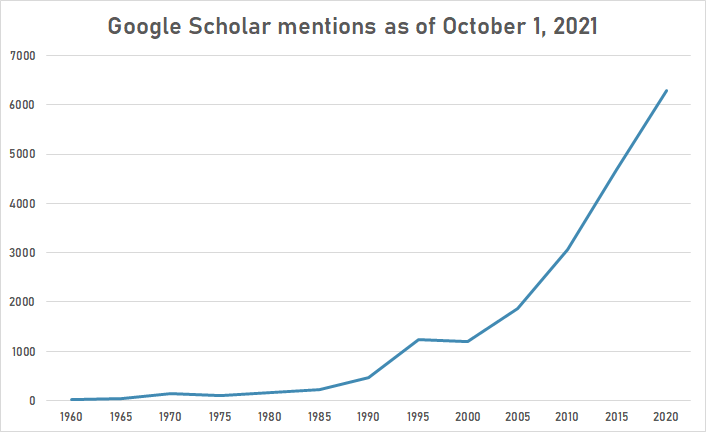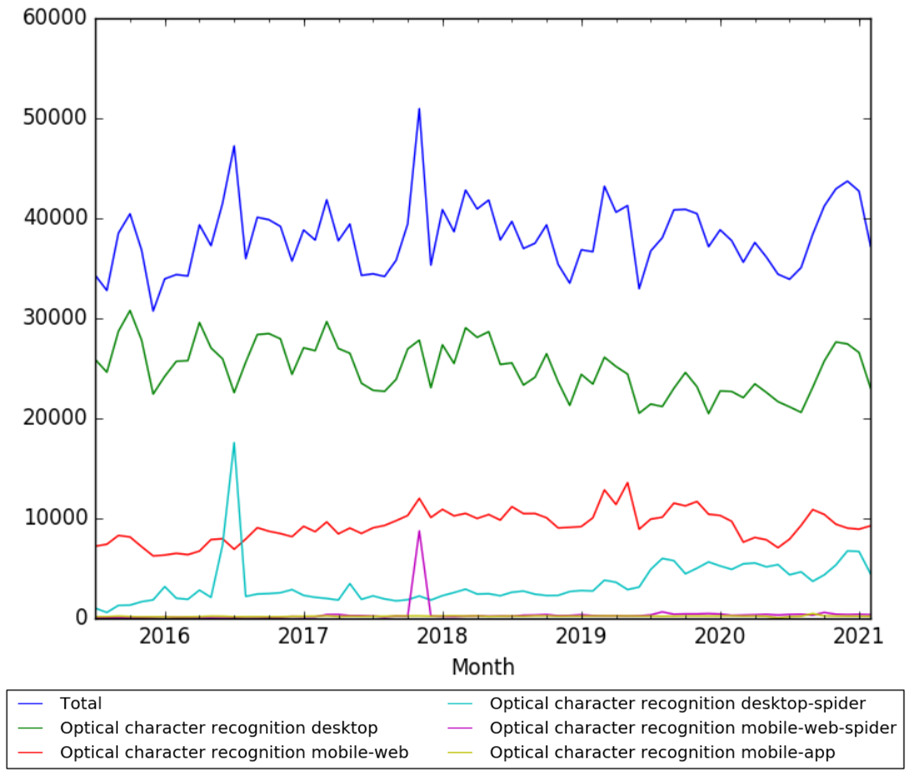Timeline of optical character recognition
Jump to navigation
Jump to search
The content on this page is forked from the English Wikipedia page entitled "Timeline of optical character recognition". The original page still exists at Timeline of optical character recognition. The original content was released under the Creative Commons Attribution/Share-Alike License (CC-BY-SA), so this page inherits this license.
This is a timeline of optical character recognition.
Overview
| Time period | Summary |
|---|---|
| 1870–1931 | Earliest ideas of optical character recognition (OCR) are conceived. Fournier d'Albe's Optophone and Tauschek's Reading Machine are developed as devices to help the blind read.[1] |
| 1931–1954 | First OCR tools are invented and applied in industry, able to interpret Morse code and read text outloud. The Intelligent Machines Research Corporation is the first company created to sell such tools.[2] |
| 1954–1974 | The Optacon, the first portable OCR device, is developed. Similar devices are used to digitise Reader's Digest coupons and postal addresses. Special typefaces are designed to facilitate scanning.[1][3][4] |
| 1974–2000 | Scanners are used massively to read price tags and passports.[5] Companies such as Caere Corporation, ABBYY and Kurzweil Computer Products Inc, are created. The latter one develops the first omni-font OCR software, capable of reading any text document.[6] |
| 2000–2016 | OCR software is made available online for free, through products like Adobe Acrobat, WebOCR, and Google Drive.[7][8] |
Timeline
| Year | Event type | Technology | Details |
|---|---|---|---|
| 1870 | Invention | American inventor Charles R. Carey invents the retina scanner, an image transmission system using a mosaic of photocells, considered the first OCR invention in the world.[1] | |
| 1885 | Invention | Image scanner | Paul Nipkow invents the Nipkow disk, an image scanning device that later will be a major breakthrough both for modern television and reading machines.[9] |
| 1900 | Invention | Russian scientist Tyurin envisions the first OCR machine to serve as an aid to the visually handicapped, but never manages to develop it.[1] | |
| 1912 | Product | Text-to-speech | Edmund Fournier d'Albe develops the Optophone, a handheld scanner that when moved across a printed page, produces tones that corresponded to specific letters or characters, so as to be interpreted by a blind person.[10][11] |
| 1916 | Patent | American engineer John B. Flowers patents the "One-Eyed Machine Stenographer", a machine capable of reading and typing a script. It worked by superimposing all the letters to find a point that marked each of them.[12] | |
| 1921 | Invention | Text-to-tactile sensations | Italian professor Ciro Codelupi envisions the "Reading machine for the blind", capable of transforming luminous sensations into tactile sensations.[13] |
| 1929 | Invention | Austrian engineer Gustav Tauschek creates the first OCR device called the "Reading Machine", with a photo-sensor pointing light on words when they corresponded to a content template in its memory.[14] | |
| 1931 | Patent | Text-to-telegraph | Israeli physicist and inventor Emanuel Goldberg is granted a patent for his "Statistical machine" (US Patent 1838389), which was later acquired by IBM. It was described as capable of reading characters and converting them into standard telegraph code.[1] |
| 1938 | Invention | MIT professor Vannebar Bush develops the Microfilm Rapid Selector, a similar but simpler Goldberg' statistical machine, and 40 times faster.[15] | |
| 1949 | Application | Engineers working on the Radio Corporation of America start a project to help the blind and the U.S. Department of Veterans Affairs, using the first text-to-speech techniques.[16] | |
| 1951 | Invention | Text & Morse-to-speech | American cryptoanalyst David H. Shepard and Harvey Cook Jr. build "Gismo", a machine able to read aloud letter by letter and interpret Morse code (U.S. Patent 2,663,758).[2] |
| 1952 | Company | The Intelligent Machines Research Corporation is founded by D. Shepard and William Lawless Jr, to commercialise Gismo (later renamed to "Analysing Reader").[17] | |
| 1954 | Application | American magazine Reader's Digest becomes the first business to install an OCR reader, used to convert typewritten sales reports into punched cards.[1] | |
| 1962 | Invention | Portability | Stanford professor John Linvill develops the Optacon, the first portable reading device for the blind.[18] |
| 1965 | Application | Reader's Digest expands its OCR use to digitise serial numbers of coupons. with a RCA 501 computer.Template:Fix/category[citation needed] | |
| 1965 | Invention | American inventor Jacob Rabinow develops an OCR machine to sort mail from the US Post Office.[4] | |
| 1966 | Invention | Handwriting scanner | The IBM Rochester lab develops the IBM 1287, the first scanner capable of reading any handwritten numbers.[19] |
| 1966 | Patent | Linvill is granted the patent for the Optacon, described as "Reading aid for the blind" (U.S. patent 3229387). | |
| 1968 | Invention | Typefaces | American Type Founders and Swiss designer Adrian Frutiger introduced OCR-A and OCR-B; typefaces made to facilitate OCR operations.[3][20] |
| 1971 | Application | Postal scanner | Canadian postal operator Canada Post starts using OCR systems, to read the name and address on the envelopes and to print barcodes, using ultraviolet ink (U.S. Patent 5420403).[21] |
| 1974 | Company | Omni-font | American inventor Ray Kurzweil creates Kurzweil Computer Products Inc., which develops the first omni-font OCR software, able to recognize text printed in virtually any font.[5] |
| 1976 | Company | Dallas company Recognition Equipment Inc. is founded to read credit card receipts from gasoline purchases (U.S. Patent 4027141).[9] | |
| 1977 | Company | Commercialisation | Robert Noyce founds the Caere Corporation (now Nuance Communications), and introduces the first commercial handheld OCR reader.[22] |
| 1978 | Product | Kurzweil Computer Products begins selling a commercial version of the OCR computer program, called the "Kurzweil Reading Machine".[6] | |
| 1980 | Selling | Kurzweil's company is sold to Xerox, who renamed it as Scansoft (now merged with Nuance Communications).[9] | |
| 1984 | Product | Passport scanner | Caere Corporation develops the first passport scanner for the U.S. State Department.[23] |
| 1987 | Application | Price tag scanner | American retailers Sears, Kmart and J.C. Penney start using OCR to scan price tags.[21] |
| 1989 | Company | OCR Russian company ABBYY is founded by David Yang, and starts selling products intended to simplify converting paper files to digital data.[24] | |
| 1992 | Invention | The first program that recognizes Cyrillic is invented by Russian company OKRUS.[1] | |
| 2000 | Application | Online service | OCR technology is made available online as a service (WebOCR), in a cloud computing environment, as well as in mobile applications like real-time translation of foreign-language signs on a smartphone.[25] |
| 2005 | Application | Software | The free cross-platform OCR engine Tesseract is published by Hewlett Packard and the University of Nevada, Las Vegas. |
| 2008 | Application | Adobe Acrobat starts including support for OCR on any PDF file.[8] | |
| 2011 | Application | Word-frequency lookup | Google Ngram Viewer is developed to chart frequencies of words on any source printed from 1950 to 2008.[26][27] |
| 2013 | Application | The MNIST database is created to train machine learning models in pattern recognition.[28] | |
| 2015 | Application | Open access | Google offers OCR tools to scan any Google Drive files in over 200 languages for free.[7] |
Numerical and visual data
Google Scholar
The following table summarizes per-year mentions on Google Scholar as of October 1, 2021.
| Year | "optical character recognition" |
|---|---|
| 1960 | 13 |
| 1965 | 48 |
| 1970 | 134 |
| 1975 | 100 |
| 1980 | 162 |
| 1985 | 232 |
| 1990 | 471 |
| 1995 | 1,240 |
| 2000 | 1,190 |
| 2005 | 1,870 |
| 2010 | 3,060 |
| 2015 | 4,680 |
| 2020 | 6,280 |

Google Trends
The image below shows Google Trends data for Optical character recognition (Topic), from January 2004 to March 2021, when the screenshot was taken. Interest is also ranked by country and displayed on world map.[29]

Google Ngram Viewer
The chart below shows Google Ngram Viewer data for Optical character recognition, from 1950 to 2019.[30]

Wikipedia Views
The chart below shows pageviews of the English Wikipedia article Optical character recognition, on desktop, mobile-web, desktop-spider, mobile-web-spider and mobile app, from July 2015 to February 2021.[31]

See also
References
- ↑ 1.0 1.1 1.2 1.3 1.4 1.5 1.6 Schantz, H. F. (1982) The history of OCR: optical character recognition, Recognition Technologies Users Association.
- ↑ 2.0 2.1 "The First OCR System: "GISMO" (1951) : HistoryofInformation.com". www.historyofinformation.com. Retrieved 2016-09-17.
- ↑ 3.0 3.1 Frutiger, Adrian. Type. Sign. Symbol. ABC Verlag, Zurich, 1980. p. 50
- ↑ 4.0 4.1 "Optical character recognition - History". ABBYY Technology. Retrieved 18 September 2016.
- ↑ 5.0 5.1 J. Scott Hauger, Reading Machines for the Blind ( PDF ), Blacksburg, Virginia, Faculty of the Virginia Polytechnic Institute and State University, April 1995, pp. I-II, 11-13.
- ↑ 6.0 6.1 "Kurzweil Computer Products". www.kurzweiltech.com. Retrieved 2016-09-18.
- ↑ 7.0 7.1 "Paper to Digital in 200+ languages". Retrieved 2016-09-18.
- ↑ 8.0 8.1 "Press Room". Adobe Systems. 14 July 2009. Retrieved 4 December 2010.
- ↑ 9.0 9.1 9.2 "The History of OCR". Data processing magazine. 12: 46. 1970.
- ↑ EE Fournier, The Type-Reading Optophone, Our Surplus, Our Ships, and Europe's Need, and more ( PDF ), inScientific American , vol. 123, nº 19, New York, Scientific American Publishing Co., November 6, 1920, pp. 463-465.
- ↑ d'Albe, E. E. Fournier (1914-07-01). "On a Type-Reading Optophone". Proceedings of the Royal Society of London A: Mathematical, Physical and Engineering Sciences. 90 (619): 373–375. doi:10.1098/rspa.1914.0061. ISSN 1364-5021.
- ↑ La macchina che legge e che scrive (PDF), in La scienza per tutti, Year XXIII, nº 11, Milano, Casa Editrice Sozogno, 1º June 1916, p. 166. (italian)
- ↑ Macchina per leggere pei ciechi (PDF), in La scienza per tutti, Year XXVIII, nº 2, Milano, Casa Editrice Sozogno, 15 January 1921, p. 20 (italian)
- ↑ "History of Computers and Computing, Birth of the modern computer, The bases of digital computers, OCR". history-computer.com. Retrieved 2016-09-09.
- ↑ Buckland, Michael Keeble (2006-01-01). Emanuel Goldberg and His Knowledge Machine: Information, Invention, and Political Forces. Greenwood Publishing Group. ISBN 9780313313325.
- ↑ "Reading Machine Speaks Out Loud", February 1949, Popular Science.
- ↑ Douglas Martin (December 11, 2007). "David H. Shepard, 84, Dies; Optical Reader Inventor". New York Times. Retrieved June 5, 2010.
- ↑ "The Reading Machine That Hasn't Been Built Yet". AccessWorld. Retrieved 18 September 2016.
- ↑ "Rochester chronology". IBM. Retrieved 18 September 2016.
- ↑ "OCR-A Std | Typekit". typekit.com. Retrieved 2016-09-18.
- ↑ 21.0 21.1 "Overview of OCR and Its Applications" (PDF). Understanding Optical Character Recognition. Retrieved 18 September 2016.
- ↑ "History of Caere Corporation – FundingUniverse". www.fundinguniverse.com. Retrieved 2016-09-23.
- ↑ Jacobson, Gary. "No grudges, Bill Moore says, but he still seeks justice". Dallas News. Retrieved 18 September 2016.
- ↑ "Mixergy interview: How A Bulletin Board Post Changed Everything – with David Yang". Retrieved 22 August 2013.
- ↑ "Understanding Optical Character Recognition" (PDF). Bar Code & Data Acquisition. Retrieved 18 September 2016.
- ↑ "Google Ngram Database Tracks Popularity Of 500 Billion Words" Huffington Post, 17 December 2010, webpage: HP8150.
- ↑ "Culturomics, Ngrams and new power tools for Science". Retrieved 2016-09-18.
- ↑ "MNIST handwritten digit database, Yann LeCun, Corinna Cortes and Chris Burges". yann.lecun.com. Retrieved 2016-09-18.
- ↑ "Optical character recognition". Google Trends. Retrieved 26 March 2021.
- ↑ "Optical character recognition". books.google.com. Retrieved 26 March 2021.
- ↑ "Optical character recognition". wikipediaviews.org. Retrieved 26 March 2021.
Category:Optical character recognition Category:Computing timelines